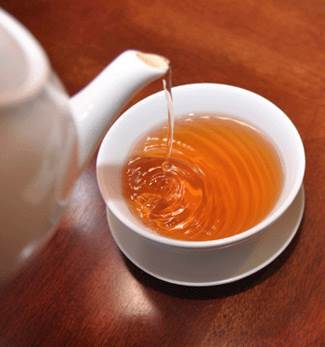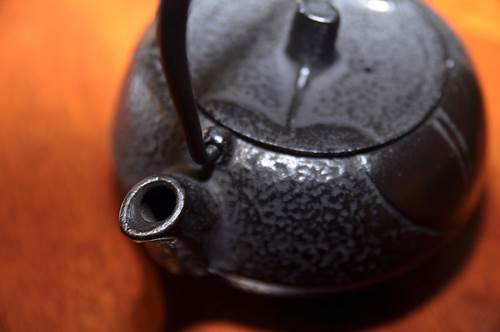
Brewing a fine pot of tea takes practice and patience. Brewing teas is nothing short of an art. About a week ago, I pulled out my favorite oolong and brewed it for my friends in a clay pot. I was really excited about the tea and eager to hear my friends’ murmurs of delight. Instead, the tea was bitter and strong right off the bat and became weak and watery after the second seep. Dejection. Humiliation.
So what I did was brew that same tea over and over to determine what exactly had happened and why. I knew that the tea I had brewed was a fine work by a master and therefore the issue was not with the tea itself, but with me. The pot was also made by a young master and, in previous sessions with buddies, had proved to be a fine pot for all oolong tea and pu’er tea.
Brewing a Good Cup of Tea
I found, after experimenting and drinking, that this particular tea required very hot water, just under boiling and that the seep should be quick and confident. I served the same tea last night and it was magnificent. Everybody loved it and I converted a few coffee heads to tea. They had never had a tea of that stature before and that is what I strive to do every time I serve a cup. Inspire, educate, enliven. The mood of the room became congenial (more than it already was) and the conversation became relaxed, yet stimulating.
I found the same thing with a Dong Ding oolong, a raw and green Dali Pu’er and even with the “simple” greens. Brewing a good cup of tea is a complicated matter and there are a few things one has to take into account.
Study Your Tea
First and foremost, study your tea. Where did it come from? Is it a dark hard leaf or a fragrant green leaf? Is it rolled into tight balls or loose? Do you know the producer? Most likely not, so go and talk to the re-seller. How does he/she brew it? What kind of taste does it have? How long can it seep? How many times?
I have noticed that there is not one tea merchant out there honest enough to say “you know, am not too sure.” And that really is the truth, because every tea has its own personality and its own perfection that it hopes to attain. Some teas want to be really flowery and attack the back of your mouth. Others want to be deep and earthy and wallow in your mouth before marching down into your belly. Some are very cerebral while others are very physical. So instead of telling you exactly which tea tastes like what and why, what I am going to do here is lay down the Scientific Method for Tasting your teas.
Its easy.
The Scientific Method for Tasting your Teas
Take 5/8/10 grams of the tea and brew it in a clay/glass/porcelain/iron pot. Do each, so that in the end you are actually drinking 12 pots of tea. Space them out over time. Seep each pot for 1/2/3 or even more minutes. So for the first seep, try it quick, not so quick and slow. Same for the second seep. Suddenly, we are talking about dozens of pots of tea. With each subset of this experiment, the tea will taste, smell and feel different. Certain subsets (say 10 grams seeped for 3 minutes) will immediately prove to be too strong, whereas 5 grams for 1 minute might be too weak. Smell the leaves after each seep. Go through the temperatures, from 85-95 degrees and see what happens. Bitter? Smooth? Burnt?
Now you might just say to yourself, 8 grams of TieGuanyin in a clay pot seeped for 2.5 minutes at 88 degrees is exactly what I am about. I would probably agree. But the goal of this process is not just to find the perfect match for each of your teas, but to truly understand what happens to the tea under other conditions. You might surprise yourself.
I found that an aged oolong needed super hot water (95 and higher) and very quick seeps (1 min or less) to open up, and each seep got longer (up to 2-1/2 minutes), but the temperature remained the same (within 94-98) — with this style of brewing, the oolong came out very, very nice and lasted a LONG time. Strange. You wouldn’t think that almost boiling water would do the trick, but after I drank it at lower temperatures, it made sense: cooler water did not release this particular tea the way it needed to be released.
Right Kind of Tea Pot
I used a Dehua green clay pot made by a friend of mine. Clay is porous, absorbs something from each session and contains minerals that will slip into your water like ninjas doing your bidding. The debate concerning pots … well, my friends, that should be a whole new post. But basically, the idea is to keep your pots with one type of tea. For example, I brew my greens in a glass and oolongs in clay and pu’ers in a different clay or iron pot. I use porcelain Gaiwans for green fragrant oolongs and also for rose hip teas or other flowery flavored teas. That’s just what I do.
In this way, you will come to know each and every tea you own. What is the benefit of this? Well, the biggest one, as far as I personally am concerned, is personality. As in, you will come to see your teas as living things (which they are, in a sense) and you will be able to choose the right tea for the right time and setting. The ability to do this is called Mastery.
And, of course, you will also understand your tools much better; After brewing with clay, porcelain, glass and perhaps iron, you will taste and smell the different ways these materials influence your tea. An added benefit is learning the effect water has; hard or soft water will affect the taste of your tea. In order to get a more perfect idea of what your tea is capable of, use completely filtered water as much as you can. Leave nothing to chance. Find out what type of material your pot is made out of and then research what that particular material REALLY is.
Investigate the Origins of Your Tea
Find out where your water comes from. Investigate the origins of your tea — was it imported? Most likely. If so, from where and by whom? Your supplier might not be eager to divulge too much information, but if you can convince him that you are not trying to open a teahouse next to his, then perhaps you can find out more about your tea. Or better yet, fly to China and get your own tea. 1000 USD round trip and maybe a couple hundred bucks for tea. Tea is not a good enough reason to make that trip? Fine, go see the Great Wall and witness China’s economic miracle first hand.
We, as consumers, must educate ourselves about what we are buying and consuming and where it is coming from. We cannot hinder or halt the global economy, but we can be interactive players within this system instead of passive gobbler of whatever tea or Product X is closest at hand (and cheapest!!). I believe that thoroughly investigating the tea you are drinking is a step in that direction. And if you do not share my views about our place in the world, then enjoy the process for what it is: a month long sojourn into the world of tea and teapots that will leave you healthier and maybe even smarter than before. 😉
 Sascha Matuszak is a German-born American writer and is currently based out of Chengdu, Sichuan Province, China.
Sascha Matuszak is a German-born American writer and is currently based out of Chengdu, Sichuan Province, China.

Leave a Reply